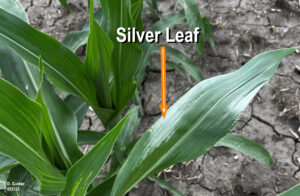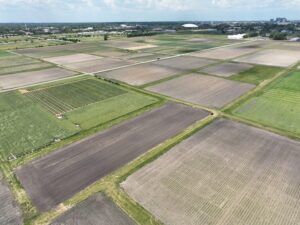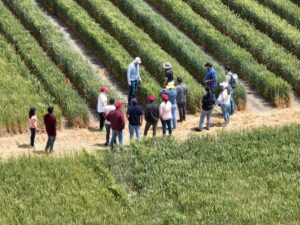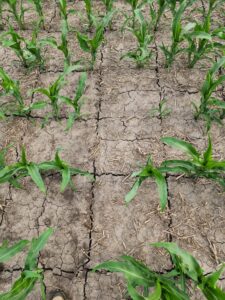Illinois Crop Update – June 2, 2023
Russ Higgins – Extension Commercial Ag Educator
Grundy County
Soil Conditions: Mildly Dry (soil is drier than normal, plant growth may have slowed)
Northeastern Illinois is turning dry. Post herbicide applications are taking place in corn fields. Despite dry conditions weed growth and diversity of species has been impressive in some fields, including robust vining weeds including burcucumber and morningglory. Early planted corn is at V6 and Soy at V2. I received reports of heavy alfalfa weevil feeding and below average tonnage from the first cutting of hay in the region. A reminder, mechanical harvest is an effective cultural control of this pest. The alfalfa weevil has one generation per year and overwinters as an adult. Mowing and harvesting the field removes the insect’s food and shelter. In addition, harvesting the crop can expose the larvae to sunlight which can be lethal. While the alfalfa weevil window of damage is nearly over, farmers are encouraged to continue to scout for other forage pests that can cause damage in future cuttings including potato leafhopper.

Figure 1: Burcucumber; Grundy County corn field.
Kathryn Seebruck – Extension Commercial Ag Educator
Ogle County
Soil Conditions: Mildly Dry (soil is drier than normal, plant growth may have slowed)
This past week went by without any rain events in the area. With only one minor rain event having occurred the previous week, coupled with higher temperatures throughout this past week, soils are drying quickly. Some fields planted since the last rain event are experiencing uneven emergence due to the lack of moisture. Some pop-up storms in the area today (May 31) may offer some, but not significant, relief.
Doug Gucker – Extension Local Food Systems and Small Farms Educator
Macon County
Soil Conditions: Mildly Dry (soil is drier than normal, plant growth may have slowed)
The cool, low humidity nights of late May have caused “silver leaf” to show in local corn fields. According to Purdue University, yield effects are negligible. Corn is mostly in the V5-V7 stage and soybean plants at about the same stage, V6-V7. Topsoil is dry down to 4+ inches fields in fields at the V6-V7 growth stages. Noticing along field edges increasing numbers of amaranth species becoming evident, and this family of weeds tolerates hot, dry weather well.

Figure 2: Silver Leaf syndrome showing up in local fields.
Nick Seiter – Extension Field Crop Entomologist
Champaign County
Soil Conditions: Moderately Dry (soil is dry, plants may be browning or stressed, water bodies are low)
We should be in the middle of corn rootworm egg hatch in much of the state by the time this report is published. Continue to look out for armyworm injury in & near wheat and other dense grasses (cover crops, weeds, waterways, etc.). Black cutworm larvae should be at cutting size throughout the state now, so include them in your scouting efforts, particularly in fields that had sub-optimal winter annual weed control. I have received relatively few reports of early season injury so far.
Dennis Bowman – Extension Digital Ag Specialist
Champaign, Macon, and Piatt Counties
Soil Conditions: Mildly Dry (soil is drier than normal, plant growth may have slowed)
Still dry. Wednesday spotted one pop-up shower that did not even register on radar app. Primary field activities: herbicide application, nitrogen side-dressing and watching corn grow.

Figure 3: University of Illinois Crop Science Research and Education Center (South Farms) Research Fields, Champaign Co.

Figure 4: Dr. Jessica Rutkoski, leads multi-state visitors through her small grain research plots. Wheat at Feekes 11.1 (milk stage). Champaign Co.

Figure 5: Checkerboard soil cracks in 20″ corn field (end rows) Corn at V6. Windshield survey illusion, rows appear almost closed from the road. Piatt Co.
Nathan Johanning – Extension Commercial Agriculture Educator
Monroe County
Soil Conditions: Severely Dry (soil is very dry, water bodies are very low, vegetation is stressed)
Unfortunately, like most we have not gotten any measurable rainfall over the past week, and with the temperatures starting to get into the 90s, it is really putting some stress on our crops. The latest planted crops are the most severely hit but all are showing some signs of stress. Locally, the central part of Monroe County has been hit the hardest, missing rainfall that has gone to the north and to the south. Hillsides of some corn fields are stressed and rolled up or bare, with little emergence or stand. Many fields under normal conditions would be candidates to replant or at least patch in bare areas, however, with no soil moisture and no promising chances in the forecast there really isn’t any point to put more seeds out right now. From the Illinois Wheat Association field tour, the general consensus was that overall, the wheat crop and yield estimates favored a very good crop in 2023. The wheat crop is turning very quickly which is being accelerated by the dry conditions.

Figure 6: Corn fields stressed in the driest part of the region with variable emergence.
Talon Becker – Extension Commercial Agriculture Educator
Franklin County
Soil Conditions: Mildly Dry (soil is drier than normal, plant growth may have slowed)
It was a warm, dry week in Franklin County, like much of the state. With this, soils in the better drained fields or parts of fields are getting dry enough that crop growth has appears to have slowed. However, with relatively good soil moisture levels in the county heading into this week, plant stress is still minimal, particularly in the lower lying areas. That may change as we head into next week with little rain in the forecast and temps still in the 90s on some days. The wheat in the area is still looking good overall, and much of it has started to senesce.





